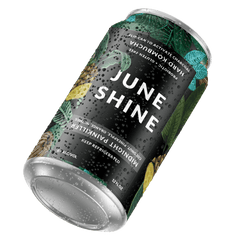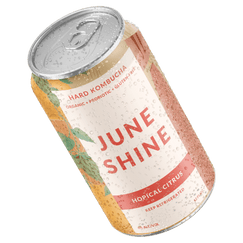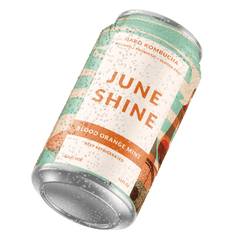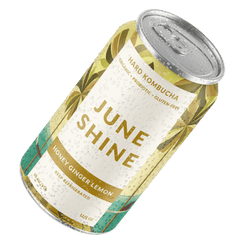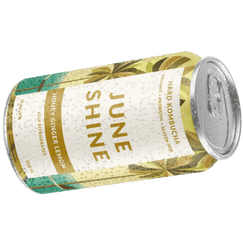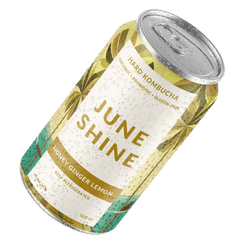What Are Hops? What You Didn’t Know About Hops in Brews

The term “hoppy” is common vernacular in the beer-loving crowd. But what are hops, and what do they taste like? Besides beer making, there are quite a few uses for these green flowers—including flavoring hard kombucha.
What Are Hops?
The origin of hops is not fully known, but they likely originated in China and were later brought to Belgium and the rest of Europe.
Humulus lupulus is part of the hemp family, growing on a bine (and no, that’s not a typo) and producing small, aromatic buds yearly. Inside the buds are yellow cones, which are the reason for hops’ distinctive taste. With deep root systems stretching into 16 feet of soil or more, the hefty structures of this plant require support to remain upright.
What Do Hops Taste Like?
You’ve probably heard someone describe their beer as “hoppy,” but you may not have been sure what that meant. When someone calls their beer hoppy, they’re referring to the bitterness of the brew.
If you’ve tried an IPA (aka an India Pale Ale), you know it has a strong flavor that separates it from other beers. IPAs have a strong, bitter hop flavor, and they’re probably the best example of a beer that tastes hoppy. In contrast, a light lager has a lower amount of hops and a much milder, maltier taste.
International Bitterness Units
International Bitterness Units (IBUs) measure the bitterness of a beer. Since everyone’s perception of bitterness or hoppiness is subjective to their preferences, this scale is used to give a numeric value to the chemical compounds that create bitter flavors. The scale ranges from one to 100, with 100 being the most hoppy and bitter.
Imperial Stouts are highest on the scale, with IBUs of 60-80, and Berliner Weisse beers are the lowest, sitting around four to six on the IBU scale.
What Kinds of Beer Have Hops?
Despite the varying levels of hoppiness that you’ll find in different beers, all kinds of beers have hops added late in the brewing process. Some just have more than others or use a stronger variety. Not all hops bring the same level of distinct flavor and smell, depending on their place of origin.
Without hops, beer would be overly sweet. Hops help tone down the sweetness by counteracting it with a bitter flavor.
Where Are Hops Grown?
Hops are picky about where they grow. They prefer locations between the 35th and 55th parallels of the Northern or Southern hemisphere. These places provide the ideal growing conditions of cold, dormant winters and warm, sunny summers with long days.
Hops also require specific soil types, drainage, and acidity levels.
The United States
The US produces the most hops of any country in the world. The Pacific Northwest region of the United States has ideal growing conditions for harvesting hops, stretching across Oregon, Washington, and into Idaho.
Washington provides over 69% of hops production in the United States, equating to 113 million pounds in 2019. Less than one percent are grown in areas outside the Pacific Northwest, in places like Michigan, Wisconsin, and California.
Europe
In Europe, hops are mostly produced in England, Germany, and Belgium.
The second-biggest hops producer in the world is Germany, where hops were first introduced to beer. In 2019, this region produced an impressive 106 million pounds of hops. This area is unique, as it still grows some of the earliest hop varieties ever known.
China
Still located along the 35th and 55th parallels, China takes the medal for third-largest producer of hops in the world. In 2019, they grew and sold 15.5 million pounds of hops.
With the typical crop producing 2,000 pounds of hops per acre, that’s a lot of farmland devoted to hops.
How Are Hops Grown?
Since they’re perennials, hops are continually in a cycle of producing and hibernating. Unlike annuals that die at the end of each harvest, perennials don’t need replanting every year. Hop crops are typically planted between March and May, after the last freeze.
When initially planted as a seed, hops take about two years until they are ready for harvesting as they build their intricate root systems. These plants are fast-growing, and they can grow as much as 12 inches in one day.
Once the roots and bine structures have fully developed, the plants are ready to flower. Even still, knowing exactly when to pick hops is a careful science, as they must be the perfect level of ripeness. When the hops are finally ready, harvesting takes place in the fall, and the hops are dried until they are primed for use.
Uses for Hops
In addition to their use in beers, hops can also be used to flavor foods. Use dried hops as a garnish for a fresh salad, in a chicken marinade, or even atop fresh bruschetta.
Here’s one use you would never expect to hear: Hops can be used as a natural odor fighter. In some natural deodorant brands, hops are an active ingredient that naturally fights odor-causing bacteria.
Along the same lines, the Czech Republic offers hops spas and baths, which they claim are physically and mentally purifying. After soaking in a bathtub of hops, yeast, and warm water, spa guests relax on a bed of straw, allowing their bodies time to absorb the nourishing ingredients from the bath.
Our Favorite Way to Use Hops
You may be wondering why we’re talking so much about hops when we make hard kombucha here at JuneShine. We love the flavor of hops, too, and we found a way to mix them into one of our favorite flavors.
Hopical Citrus is a blend of grapefruit and pineapple, citrus zest, green tea, and Jun Kombucha. To top off that enticing medley of flavors, we added Simcoe and Cascade for a sessionable, easy-to-drink brew. With 6% Alcohol By Volume (ABV) and only 140 calories in a 12 ounce can, this one is sure to please even the finest of hop connoisseurs.
Sources:
Weird Ingredient Wednesday: Hops—They're Not Just for Beer Anymore | Wonder How To
